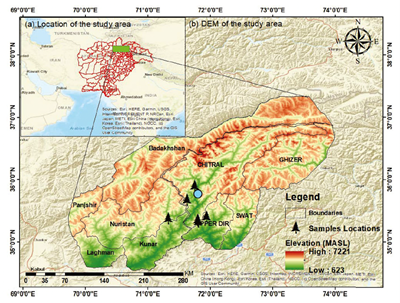Tree rings reveal 400 years of rainfall patterns, forecasting an increase in extreme weather conditions in Pakistan and Afghanistan.
SUTD - Stefano Galelli
Columbia University - Hung T. T. Nguyen
University of British Columbia - Paolo Cherubini
WSL Swiss Federal Institute for Forest - Nasrullah Khan
The study is an important step towards the understanding of long-term changes in the water cycle and will aid in more informed decisions when assessing and managing regional water systems.
 The 2022 Pakistan flood as observed in Malakand, near the study site.
The 2022 Pakistan flood as observed in Malakand, near the study site.
From June to October 2022, Pakistan was hit by devastating floods that displaced more than 30 million people and caused damages amounting to around US$15 billion. Unfortunately, that was not an isolated calamity - droughts were a major source of concern just a few months before the monsoon floodings.
What is causing this sequence of extreme events?
A team of scientists from Pakistan, US, Switzerland, and Singapore has shown that the cause of such phenomena is the intensification of the hydrological cycle, which increases the frequency of droughts and floods.
Scientific evidence in support of this hypothesis is provided by tree rings, which ‘record’ the duration and intensity of past climate conditions. Using data from the Hindu Kush Mountains, the scientists were able to reconstruct annual precipitation in the Kabul River Basin (refer to figure below) over a period of almost four centuries spanning from 1637 to 2018.
 Visual representation of the study region, including the Kabul River Basin and the sites in which tree rings were sampled.
Visual representation of the study region, including the Kabul River Basin and the sites in which tree rings were sampled.
“Our precipitation data show alarming trends,” shared Dr Nguyen, the corresponding author (Columbia University). “By looking at trends in the past four centuries, we clearly see that droughts are getting more severe, shorter, and more frequent, interspersed with more frequent wet periods.”
Floods and droughts are not mutually exclusive; they are a feature of natural hydro-climatological variability. In a warmer climate, though, the rate and intensity with which these phenomena manifest themselves is likely to increase — as we are witnessing in central Asia.
“The consequences for the management of natural resources are vast,” added Dr Galelli, co-author from the Singapore University of Technology and Design. “The hydrological cycle affects multiple socio-economic sectors, so we need to re-think our approach to infrastructure planning and operations. What we are starting to witness is a profound need for climate adaptation and mitigation.”
The findings of this study was published in Geophysical Research Letters and presented at the American Geophysical Union Fall Meeting in December 2022.
 One the scientists sampling a Himalayan cedar tree in northern Pakistan.
One the scientists sampling a Himalayan cedar tree in northern Pakistan.
Acknowledgements
Nasrullah Khan's visit to Paolo Cherubini's laboratories was funded by the Swiss National Science Foundation (Grant IZSEZ0_186442). Part of the dendrochronological data were developed during Nasrullah Khan’s PhD dissertation work, mentored by Moinuddin Ahmed and Jonathan Palmer, supported by the Higher Education Commission of Pakistan Grant 20-422/R&D (Principal Investigator: Moinuddin Ahmed). Part of the data was developed in a Pak-US joint project (Principal Investigators: Moinuddin Ahmed and Edward Cook), supported by the U.S. Agency for International Development (USAID) NAS Grant PGA-P280423. We thank Jonathan Palmer for his important contributions to the tree ring data. Hung Nguyen is supported by the Lamont-Doherty Postdoctoral Fellowship. The authors thank Boniface Fosu, the editors, and the three anonymous reviewers for their useful suggestions. Our figures made use of colours from https://colorbrewer2.org by Cynthia A. Brewer, Department of Geography, Pennsylvania State University.
Reference
Increasing Drought Risks Over the Past Four Centuries Amidst Projected Flood Intensification in the Kabul River Basin (Afghanistan and Pakistan)—Evidence From Tree Rings, Geophysical Research Letters. (DOI: 10.1029/2022GL100703)